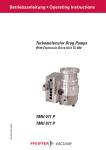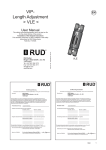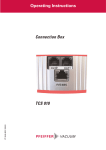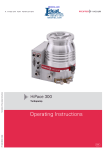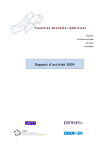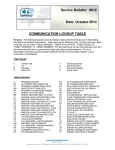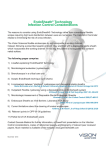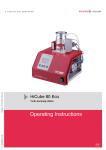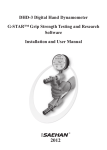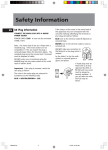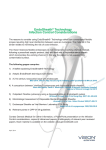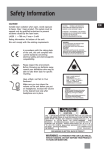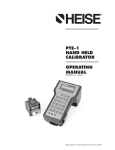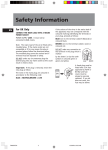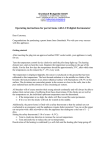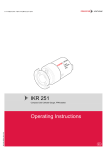Download Pfeiffer Diaphragm Membrane Vacuum Pump MVP 015
Transcript
Betriebsanleitung • Operating Instructions Translation of the Original Operating Instructions Diaphragm Pump PK 0202 BE/E (1001) MVP 015-4 Index Page 1. Safety Precautions.......................... 3 1.1. For Your Orientation ......................................... 3 1.2. Pictogram Definitions ....................................... 3 2. Understanding The Pump.............. 4 2.1 Main Features................................................... 4 2.2. Differences Between The Pump Types............ 4 3. Installation....................................... 5 3.1. Setting Up The Pump And Location ................. 5 3.2. Connecting The Vacuum Side........................... 5 3.3. Connecting The Exhaust Side........................... 5 3.4. Connecting To Mains Power ............................ 5 4. Operations....................................... 6 4.1. Important Information....................................... 6 4.2. Switching ON/OFF The Pump .......................... 6 4.2. Intermittent Operations .................................... 6 5. What To Do In Case Of Breakdown? ...........................................................7 6. Maintenance.................................... 8 6.1. Precautionary Measures During Maintenance Work ................................................................. 8 6.2. Cleaning And Replacing Valves And Membranes .......................................................................... 8 6.3. Dismantling The Pump ..................................... 8 6.4. Assembling The Pump...................................... 8 7. Service ........................................... 10 8. Technical Data................................ 11 8.1. Substances Which Come Into Contact With The Medium ................................................... 11 8.2. Dimensions..................................................... 12 9. Spare Parts .................................... 12 10. Accessories.................................... 12 Conformity Declaration ........... last page 2 Please note: Current operating instructions are also available via www.pfeiffer-vacuum.net. 1. Safety Precautions ☞ Read and follow all the instructions in this manual. ☞ Inform yourself regarding: ☞ Hazards which can be caused by the pump; ☞ Hazards which can arise in your system; ☞ Hazards which can be caused by the medium being pumped. ☞ Avoid exposing any part of the body to vacuum. ☞ Observe all safety and accident prevention regulations. ☞ Check regularly that all safety requirements are being complied with. ☞ Do not carry out any unauthorised conversions or modifications on the pump. ☞ When returning the pump to us please note the shipping instructions in Section 7. ☞ Do observe strictly the proper use. Proper use – The Diaphragm Pump may only be used for the purpose of generating vacuum. – Do not pump corrosive or explosive gases. – Do not pump liquids. – Do not operate the pump in locations where there is an explosion hazard. – Accessories other than those named in this manual may not be used without the agreement of Pfeiffer Vacuum. – Do not use the connecting line between the heads of the pump as a handle. – Equipment must be connected only to a suitable fused and protected electrical supply and a suitable earth point. – Ensure that installation is in compliance with limitations from the degree of protection, see section “Technical Data“. 1.1. For Your Orientation Instructions in the text ➡ Operating instructions: Here you have to do something! Symbols used The following symbols are used throughout in the illustrations: Vacuum flange Exhaust flange Power supply connection Position numbers Identical components and accessories parts have the same position numbers in all illustrations. 1.2. Pictogram Definitions Danger of personal injury. WARNING Danger of damage to the pump or system. CAUTION Danger of burns from touching hot parts. WARNING Danger of an electric shock. WARNING PLEASE NOTE Attention to particularly important information on the product, handling the product, or to a particular part of the documentation. ☞ Improper Use The following are regarded as improper: – The pumping of corrosive gases (except with corrosive gas processes version). – The pumping of explosive gases. – Operating the pump in locations where there is an explosion hazard (a special version for this application is available on request). – The pumping of gases which are contaminated with particles, dust and condensate. – The Pump may not be used for the purpose of generating pressure. – The pumping of liquids. – Connection to pumps and units which is not permitted according to their operating instructions. – Connection to units which contain touchable and voltage carrying parts. Improper use will cause any rights regarding liability and guarantees to be forfeited. Modifications reserved 3 2. Understanding The Pump 2.1. Main Features 2.2. Differences Between The Pump Types Diaphragm Vacuum Pump MVP 015-4 Features 1 2 3 4 5 6 7 9 Volume flow rate at 1000 mbar and 50 Hz Pump stages Connection of the membrane heads Final pressure at 50 Hz Mains connection Membrane head 1 Membrane head 2 Membrane head 3 Membrane head 4 Vacuum flange (direct screw joint Voltage supply Exhaust (silencer) Capacitor 7 4 9 6 3 MVP 015-4 5 1 2 The diaphragm pump can be applied in all areas where an oilfree, dry vacuum is required. Particularly the pump is suitable as backing pump for many Pfeiffer Vacuum turbopumps in applications involving light gas loads only. Further applications: – Pumping stations – Plants Research Laboratories Analytical Chemistry Leak detection 4 Unit l/min MVP 015-4 15 four-stage 1-->2 in series 3-->4 in series mbar < 0.5 Connecting cable hard-wired in terminal box, without mains switch 3. Installation 3.1. Setting Up The Pump And Location ➡ Place pump on a smooth, even surface. ➡ Anchor the pump if it is to be erected in a stationary position. ➡ Avoid mechanical stresses due to rigid connections. Insert elastic hoses or resilient elements as couplings between the pump and rigid pipes. ➡ Anchoring is not necessary if the pump is not erected in a stationary position. ➡ Maximum ambient temperature +12 ... +40 °C. ➡ Where rack installation is involved, ensure adequate ventilation. If pump is installed above 1000 m above mean sea level check compatibillity with applicable safety requirements, e. g. DIN VDE 0530 (motor may overheat due to insufficient cooling). CAUTION Pump versions where the thermostatic winding protection protrudes must be appropriately wired to ensure the motor is protected. Normal version Motor 3.2. Connecting The Vacuum Side – Remove locking cap on intake connection. – Make connection between the vacuum system and pump as short as possible. – Connect pump with intake connection to the apparatus. – If liquid - which would generate vapours - is present in the system to be evacuated, a condensate trap must be fitted upstream of the pump. 3.3. Connecting The Exhaust Side Pressure can rise to dangerous levels in exhaust lines. Therefore, lay exhaust side lines without shut-off units. Do not connect the exhaust side with a closed system on account of the danger of bursting. In certain applications, exhaust gases and vapours can be very hot and represent a health and/or environment hazard. Lay lines from the pump sloping downwards so that condensate cannot run back into the pump, otherwise fit a separator. CAUTION 3.4. Connecting To Mains Power The pump is driven by AC motors with the following possible variants: 230 V + 5% / -10%, 50 Hz 120 V + 5% / -10%, 60 Hz WARNING Power connections must comply with local regulations. Voltage and frequency information given on the rating plate must correspond to the mains voltage and frequency values. The pump may only be connected to mains current with earthed conductor. 5 4. Operations 4.1. Important Information CAUTION Before starting, ensure that impermissibly high pressures cannot build up on the pressure side. Interchanging the connections causes dangerous excess pressure levels. The pumps should only start, when the pressure difference is max. 1 bar between admission and exhaust, because the motor will be blocked and damage. WARNING When the pump is running, surfaces and motor casing become hot. 4.3 Intermittent Operations To prolong the life of diaphragm pumps, intermittent operations can be selected with lesser gas throughputs of < 0.18 mbar l/s. This means that, dependent on the turbo pump power take-up, the backing pump will be switched on and off. Turbo pump power take-up is dependent on the forevacuum pressure and gas throughput. – By comparing the power take-up with an upper and a lower limit value, the relative switch-on duration with lesser gas throughputs can be reduced to approx. 1 to 60% – To avoid too frequent switching on, the buffer volume in the fore-vacuum line should amount to < 0.5 liter from approx. 0.018 mbar l/s. Possible intermittent operations variations are shown in the following diagram: 4.2 Switching ON/OFF The Pump The pump can be switched on and off at all times. CAUTION Prevent internal condensation, transfer of liquids or dust. The diaphragm and valves will be damaged, if liquids are pumped in significant amount over lengthy periods! If the pump is subjected to condensates it should be allowed to run for a few minutes under atmospheric pressure before switching off. 6 3 4 L N PE PE N L´ MVP-Reihe MVP series TC Acc. A Connection of Diaphragm Pump with relay box (PM 061 372 -T/374-T) on TC for intermittent operations 5. What To Do In The Case Of Breakdowns ? Problem Pump does not attain final pressure Unusual operating noises Pump does not start Pump switches off Possible cause • Condensate in the pump Remedy • Run pump for a longer period under atmospheric pressure • Valves/diaphragms defective/dirty • Clean or replace valves and diaphragms, see section 6. • Leak in system • Repair leak Valves/diaphragms defective See maintenance in section 6. Dirt in the working chamber Clean working chamber. Silencer loose or missing Check silencer; clean or replace. Valves defective Change valves. Motor fan defective Change motor fan. Con-rod or motor bearing defective Inform Pfeiffer-Service. No mains voltage Check power supply. Phase failure Check fuse. Motor overheating Allow the motor to cool down and depress mains switch off/on. Ambient temperature < 12 °C Warm pump. Dirty valves/diaphragms See maintenance in section 6. Over-pressure in the exhaust line Open exhaust line (open exhaust valve). • Sticking diaphragms • Clean pump (see section 6.) • Wrong mains voltage • Correct as per rating plate 7 6. Maintenance 6.1. Precautionary Measures During Maintenance Work CAUTION Whenever working on the pump ensure the motor cannot get switched on. If necessary, remove pump from the system for inspection. Before dismantling allow the pump to cool down. ➡ Only dismantle the pump as far is necessary to effect repairs. ➡ Use only benzin or the like for cleaning. Do not use solvents. 6.2. Cleaning And Replacing Valves And Membranes Under normal operating conditions, the pump is maintenance free. The valves and the diaphragms are wear parts. If the rated ultimate vacuum is no longer achieved, the pump interior, the diaphragms and the valves must be cleaned and the diaphragms and valves must be checked for cracks or other damage. Depending on individual cases it may be efficient to check and clean the pump heads on a regular basis. In case of normal wear the lifetime of the diaphragms and valves is > 10000 operating hours. CAUTION There can be different numbers of washers 17 in each membrane head. Ensure the correct assignment for mounting when dismantling the membrane heads. Don’t confuse the washers 17. 6.3. Dismantling The Membrane Head ➡ Allow the pump to cool down before dismantling. ➡ Using an SW 14 key, unscrew direct screw joint (20) of interhead connection (10) on diaphragm head 1 (see marks on the housing). ➡ As far as possible place pump on its side so that the head to be dismantled points up. ➡ Using an SW 3 key, unscrew the four Allan head screws (11) and remove head cover (12), taking care with the two valve plates (13) and sealing rings (14). ➡ Remove intermediate plate (15). ➡ Use a small screwdriver to carefully ease out diaphragm (16) and manually unscrew from the connecting rod (righthand thread). Look out for possible washers (17). ➡ Clean all parts with alcohol and examine diaphragms, valves and seals for possible damage and renew as necessary. If a new diaphragm is to be fitted, the washers (17) of the old diaphragm must be used again otherwise the pump will not attain the required pressure. 8 6.4. Assembling The Membrane Head ➡ Assemble all parts in reverse order. The connecting rod should be positioned in the upper dead point when fitting the diaphragm. Ensure correct positioning of all parts. ➡ Check correct sealing ring seating. ➡ Re-make hose connection and re-tighten direct screw joint (20). ➡ Test pump for function. Dismantling the membrane head 11 12 13 14 Allan head screw Head cover Valve plate Sealing ring 11 15 1 2 4 5 7 9 10 10a 11 20 15 Intermediate plate 16 Diaphragm 17 Washer 12 13 16 17 14 Membrane head 1 Membrane head 2 Membrane head 4 Vacuum flange (direct screw joint) Exhaust (silencer) Capacitor Interhead connection 1-2 Interhead connection 2-3 Allan head screw direct screw joint 1 11 9 20 10 4 2 10a 7 1 5 9 Do Make Use Of Our Service Facilities In the event that repairs are necessary to your pumping station, a number of options are available to you to ensure any system down time is kept to a minimum: – Have the pump repaired on the spot by our Pfeiffer Vacuum Service Engineers; – Return the individual components to the manufacturer for repairs; – Replace individual components with a new value exchange units. Local Pfeiffer Vacuum representatives can provide full details. Returning contaminated units If contaminated have to be returned for maintenance/repair, the following instructions concerning shipping must be followed: ➡ Neutralise the pump by flushing with nitrogen or dry air. ➡ Seal all openings to the air. ➡ Seal pump or unit in suitable protective foil. ➡ Return equipment only in suitable, rugged shipping containers and by complying with the currently valid shipping regulations. Before Returning: ➡ Dismantle all accessories. ➡ Attach a clearly visible notice: “Free of contamination” (to the unit being returned, the delivery note and accompanying paperwork). Harmful substances" are substances and preparations as defined in current legislation. Pfeiffer Vacuum will carry out the decontamination and invoice this work to you if you have not attached this note. This also applies where the operator does not have the facilities to carry out the decontamination work. Units which are contaminated microbiologically, explosively or radioactively cannot be accepted as a matter of principle. ☞ 7. Service Fill out the service request and the declaration on contamination ➡ Download the forms “Service Request” and “Declaration on Contamination”.1) ➡ Fill out the “Service Request” form and send it by fax or e-mail to your Pfeiffer Vacuum service address. ➡ Include the confirmation on the service request from Pfeiffer Vacuum with your shipment. ➡ Fill out the contamination declaration and enclose it in the shipment (required!). Please get in touch with your local Pfeiffer Vacuum representatives if there are any questions regarding contamination. WARNING 1) Decontaminate units before returning or possible disposal. Do not return any units which are microbiologically, explosively or radioactively contaminated. Forms under www.pfeiffer-vacuum.net 10 PLEASE NOTE Repair orders are carried out according to our general conditions of sale and supply. ➡ If repairs are necessary, please send the unit together with a short damage description to your nearest Pfeiffer Vacuum Service Center. 8. Technical Data Size Connections Intake side Pressure side Nominal volume flow rate at 1000 mbar 50 Hz 60 Hz Volume flow rate at 10 mbar 50 Hz 60 Hz Final pressure Permissible exhaust pressure Leakrate to vacuum chamber when pump is switched off Integral Leakrate Max. operating altitude (a. s. l.) Max. permissible gas- and environment temperature Overload protection (coiled temperature switch) Noise level Motor (insulation material class B) Power at 230 V 50 Hz Power at 115 V 60 Hz Weight, approx. Unit MVP 015-4 G 1/8“+silencer G 1/8“+silencer l/min l/min 15 18 l/min l/min mbar mbar 4 4,5 ≤ 0.5 1050 mbar l/sec mbar l/sec m ≤ 5.10-3 ≤ 1.10-3 approx. 2000 °C +12 ... +40 °C dB(A) 118 ca. 52 IP 54 80 80 7.5 W W kg 8.1. Substances Which Come Into Contact With The Medium Pump components Diaphragm Valves Pump head Tupe Swivelling screw-fitting Silencer Substances in contact with the media (MVP 015-4) EPDM EPDM Aluminium PVC Aluminium Polyamide 11 8.2. Dimensions 9. Spare Parts Pos. 7 Description MVP 015-4 Spare parts pack contains all necessary wear parts: Silencer Pieces Size Number Comments/relevant 2 PU E22 009 -T 1 PO 920 567 E not included in the delivery consignment not included in the delivery consignmen Ord. Quantity When ordering accessories and spare parts please be sure to state the full part number. When ordering spare parts please state additionally the unit type and unit number (see rating plate). Please use this list as an order form (by taking a copy). 10. Accessories Description Relaybox, 1 phas. 5A for connection to TC 110 Relaybox, 1 phas. 5A for connection to TC 400 12 Pieces 1 Size 94 x 65 x 57 (mm) Number PM 061 372 -T 1 94 x 65 x 57 (mm) PM 061 374 -T Comments/relevant Konformitätserklärung Declaration of Conformity nach EG-Richtlinie/according to the EC directive: - Maschinen/Machinery 2006/42/EG (Anhang/Annex II, Nr. 1 A) Hiermit erklären wir, dass das unten aufgeführte Produkt allen einschlägigen Bestimmungen der EGMaschinenrichtlinie 2006/42/EG entspricht. Zusätzlich entspricht das unten aufgeführte Produkt allen einschlägigen Bestimmungen der EG-Richtlinie "Elektromagnetische Verträglichkeit" 2004/108/EG . Bevollmächtigter für die Zusammenstellung der technischen Unterlagen ist Herr Sebastian Oberbeck, Pfeiffer Vacuum GmbH, Berliner Straße 43, 35614 Aßlar. We hereby declare that the product cited below satisfies all relevant provisions of EC Machinery Directive 2006/42/EC. In addition, the product cited below satisfies all relevant provisions of EC Directive "Electromagnetic Compatibility" 2004/108/EC . The agent responsible for compiling the technical documentation is Mr. Sebastian Oberbeck, Pfeiffer Vacuum GmbH, Berliner Straße 43, 35614 Aßlar. Produkt/Product: MVP 015-4 Angewendete Richtlinien, harmonisierte Normen und angewendete, nationale Normen und Spezifikationen/ Guidelines, harmonised standards and national standards and specifications which have been applied: DIN EN ISO 12100-1 : 2004 DIN EN ISO 12100-2 : 2004 DIN EN 1012-2 : 1996 DIN EN 60335-1 : 2007 DIN EN 55014-1 : 2007 DIN EN 55014-2 : 2009 DIN EN 61000-3-2 : 2006 DIN EN 61000-3-3 : 2009 Unterschriften/Signatures: Pfeiffer Vacuum GmbH Berliner Str. 43 35614 Asslar Germany Unterschriften: (M. Bender) Geschäftsführer Managing Director (Dr. M. Wiemer) Geschäftsführer Managing Director CE/2010 Vacuum is nothing, but everything to us! Turbopumps Rotary vane pumps Roots pumps Dry compressing pumps Leak detectors Valves Components and feedthroughs Vacuum measurement Gas analysis System engineering Service Pfeiffer Vacuum Technology AG · Headquarters/Germany Tel. +49-(0) 64 41-8 02-0 · Fax +49-(0) 64 41-8 02-2 02 · [email protected] · www.pfeiffer-vacuum.net














